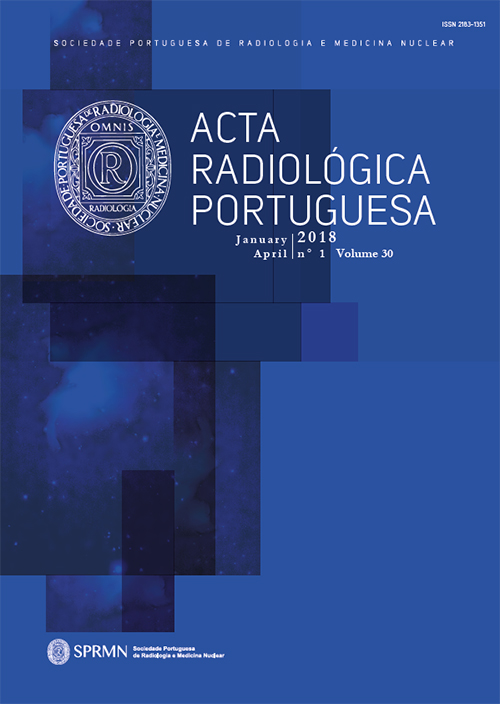Endovascular Treatment of Splanchnic Pseudoaneurysms Following Blunt Solid Organ Injuries in Children
DOI:
https://doi.org/10.25748/arp.13548Resumo
Non operative management is currently the standard treatment of blunt abdominal solid organ injuries grades I-IV (American Association for the Surgery of Trauma’s organ injury scale) in children. Even though post-traumatic splanchnic pseudoaneurysms are an infrequent complication, they may potentially lead to life-threatening intra-peritoneal or retroperitoneal bleeding. In adults, the relationship between failure of conservative management in abdominal trauma patients and delayed rupture of a pseudoaneurysm identified in follow-up imaging is well established, as is the capability of selective angioembolization to decrease non operative management failure rate. In the pediatric population, the clinical and prognostic significance of splanchnic pseudoaneurysms remains controversial and, currently, there are no high-level evidence-based guidelines on its management. The authors of this paper present 3 cases of post-traumatic abdominal pseudoaneurysms in children which were identified in imaging exams after conservative management, successfully treated by selective embolization, and a review of the literature regarding this subject is also presented. Although prospective randomized-controlled trials are needed to better define the incidence, natural history and optimal management of abdominal PAs in pediatric blunt abdominal trauma, we believe that selective angioembolization provides a safe and effective therapy for its treatment and should be considered as part of the multidisciplinary trauma management protocol in children.
Referências
Saad NEA, Saad WE, Davies MG, et al. Pseudoaneurysms and the Role of Minimally Invasive Techniques in Their Management. Radiographics. 2005;25(1):173–90.
Martin K, Vanhouwelingen L, Bütter A. The significance of pseudoaneurysms in the nonoperative management of pediatric blunt splenic trauma. J Pediatr Surg. 2011; 46(5):933–7.
Iacobellis ABF, Villamaina URE. Non operative management of blunt splenic trauma: a prospective evaluation of a standardized treatment protocol. Eur J Trauma Emerg Surg. 2016;42(5):1–6.
Haan JM, Bochicchio G V, Kramer N. Nonoperative Management of Blunt Splenic Injury : a 5-year experience. J Trauma. 2005; 58(3):492-8.
Cheynel N, Loffroy R, Guiu B, et al. Transcatheter Arterial Embolization of Splenic Artery Aneurysms and Pseudoaneurysms: Short- and Long-Term Results. Ann Vasc Surg. 2008;22(5):618-26.
Finley DS, Hinojosa MW, Paya M, et al. Hepatic Artery Pseudoaneurysm: A Report of Seven Cases and a Review of the Literature. Surg Today. 2005;35(7):543–7.
Lynn KN, Werder GM, Callaghan RM, et al. Pediatric blunt splenic trauma: a comprehensive review. Pediatr Radiol. 2009; 39(9):904–16.
Soudack M, Epelman M, Gaitini D. Spontaneous Thrombosis of Hepatic Posttraumatic Pseudoaneurysms: sonographic and computed tomographic features. J Ultrasound Med. 2003;22(1):99–103.
Khoo I, Lim F, Miao P, et al. Prophylactic embolization of hepatic artery pseudoaneurysm after blunt abdominal trauma in a child. J Pediatr Surg. 2010; 45(4):837–9.
Bhullar IS, Frykberg ER, Siragusa D, et al. Selective angiographic embolization of blunt splenic traumatic injuries in adults decreases failure rate of nonoperative management. J Trauma Acute Care Surg. 2012;72(5):1127-34.
Durkin N, Deganello A, Sellars ME, et al. Post-traumatic liver and splenic pseudoaneurysms in children: Diagnosis , management , and follow-up screening using contrast enhanced ultrasound (CEUS). J Pediatr Surg. 2016; 51(2):289-92.
Schuster T, Leissner G. Selective Angioembolization in Blunt Solid Organ Injury in Children and Adolescents: Review of Recent Literature and Own Experiences. Eur J Pediatr Surg. 2013; 23(6):454-63.
Haan JM, Scalea TM. Blunt Splenic Injuries In The Adolescent Trauma Population : The Role Of Angiography And Embolization. JEM. 2011;41(1):21-8.
Skattum J, Gaarder C, Aksel P. Splenic artery embolisation in children and adolescents - An 8 year experience. Injury. 2014;45(1):160-3.
Schurr M, Fabian T, Gavant M, et al. Management of blunt splenic trauma: computed tomographic contrast blush predicts failure of nonoperative management. J Trauma. 1995;39(3):507-13.
Kittaka H, Yagi Y, Zushi R, Hazui H, Akimoto H. The Investigation of Posttraumatic Pseudoaneurysms in Patients Treated with Nonoperative Management for Blunt Abdominal Solid Organ Injuries. PLoS One. 2015;10(3):1-12.
Safavi A, Beaudry P, Jamieson D, Murphy JJ. Traumatic pseudoaneurysms of the liver and spleen in children: is routine screening warranted? J Pediatr Surg. 2011;46(5):938–41.
Coccolini F, Montori G, Catena F, Kluger Y, Biffl W, Moore EE, et al. Splenic trauma : WSES classification and guidelines for adult and pediatric patients. World J Emerg Surg. 2017;12(40):1–26.
Kiankhooy A, Sartorelli KH, Vane DW, Bhave AD. Angiographic Embolization Is Safe and Effective Therapy for Blunt Abdominal Solid Organ Injury in Children. J Trauma. 2010;68(3): 526-31.
Yamaçake KGR, Lucon M, Lucon AM, et al. Renal Artery Pseudoaneurysm after blunt renal trauma: Report on Three Cases and Review of the Literature. Sao Paulo Med J. 2013;131(5):356-362.
Garg A, Gokhale A, Garg P, et al. Endovascular Treatment of a Delayed Renal Artery Pseudoaneurysm Following Blunt Abdominal Trauma. Urol J. 2007; 4(3): 184-186.
Hardcastle TC, Reitz D, Hollander Dd, Rodseth R, Muckart DJ. Posttraumatic Intrahepatic Pseudoaneurysm in a Child Managed by Coil Angioembolization: a Case Report ans Literature Review. J Pediatr Surg. 2010; 45(6): 1-3.
Ong C, et al. Primary Hepatic Artery Embolization in Pediatric Blunt Trauma. J Pediatr Surg. 2012;47(12): 2316-20.
Skattum J, Jeanette R, Loekke V, Larsen T, Grete A, Aaberge IS, et al. Preserved function after angioembolisation of splenic injury in children and adolescents: A case control study. Injury. 2014;45(1):156–9.
Sclafani S, Shaftan G, Scalea T. Nonoperative salvage of computed tomography-diagnosed splenic injuries: utilization of angiography for triage and embolization for hemostasis. J Trauma. 1995;39(5):818–27.
Schimmer JAG, Steeg AFW Van Der, Zuidema WP. Splenic function after angioembolization for splenic trauma in children and adults: A systematic review. Injury. 2016;47(3):525-30.
Downloads
Ficheiros Adicionais
Publicado
Edição
Secção
Licença
Autor (es) (ou seu (s) empregador (es)) e ARP 2024. Reutilização permitida de acordo com CC BY-NC. Nenhuma reutilização comercial.



